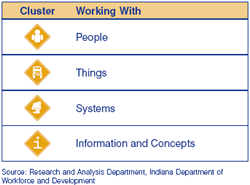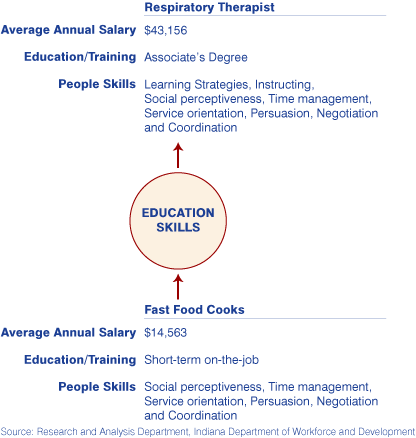Moving Toward Tomorrow's Jobs: Indiana's New Skill Pathways and Guides
How do individuals make informed choices about occupations that will provide a good “fit” for their skills and interests, along with a salary that will meet their needs? How can they navigate from where they are now to the high-demand jobs that will offer them better wages and greater job security? One part of the answer is to assess their interests, skills and current knowledge (more on that later). To address the navigation component, the Indiana Department of Workforce Development (DWD) has developed new career guides to assist Hoosiers planning their path to jobs with better wages, greater security and job satisfaction. Skill pathways, as developed by DWD's Research and Analysis division, are the foundation for the new career guides. (1)
The guides are individually tailored for two groups of Hoosiers according to their differing needs:
- Experienced Hoosier workers that find themselves unemployed, underemployed or simply dissatisfied with their current jobs and
- Those currently in school, planning their careers for the first time.
The career guides highlight the increasing importance of skills, basic and otherwise. Regardless of a job seeker's previous education or work background, he or she may have developed skills in a variety of areas that will help further his or her career or find a new job in a different field. The skill pathways in the guides draw attention to 25 “differentiating” skills that guide us to success in Indiana's high-wage and high-demand (HWHD) occupations as well as the significance of 10 basic skills important to all jobs. (2) Individuals will be able to chart their own pathways to high-wage and high-demand occupations based on the recently developed skill pathways: Working with People; Working with Things; Working with Systems; and Working with Information and Concepts (see Table 1). (3)
Table 1: The Four Skill Pathways

Each skill pathway is identified by the set of common skills that distinguish it from the others. For example, the key skills for the Working with People pathway are learning strategies, instructing, social perceptiveness, time management, service orientation, persuasion, monitoring, negotiation and coordination. For individuals who enjoy working with people and who have or can develop these skills, the guide's “People Pathway” will provide examples of occupations that value this set of skills. The guide will also list occupations within each skill pathway that require varying levels of education and experience—illustrating how increased training and education lead to higher wages. An individual working as a receptionist or information clerk might consider additional training to prepare for work as a legal secretary (a HWHD occupation with a salary increase of about $10,000). With an associate's degree, that same individual could find employment as a paralegal (also HWHD with another bump of $5,000), and with completion of a law degree, the salary jumps to $80,727.
Moving Forward
Like any career exploration tool, the guides can help students and job seekers identify possible employment opportunities, linking people to occupations based on their personal skills, their interests, past experiences and educational background. Furthermore, the skill pathways and guides support the promotion of new curriculum and skill development programs at WorkOne Centers and vocational/secondary schools. Thus, the guides benefit job seekers, employers, educators and career counselors throughout Indiana.
The skill pathway and career guides begin with a description of each of the four skill pathways, including definitions and examples of each skill. Each pathway section highlights a few of Indiana's high-wage, high-demand jobs that require similar skills. Examples include career ladders that highlight the education and work experience that can lead to future success within an individual's chosen career (see Figure 1). To provide an added touch of reality, personal testimonials from workers currently employed in these jobs have been included. The guides also contain information on additional training and/or higher education, with links to resources on curriculum, coursework and Indiana's vocational and post-secondary schools.
Figure 1: Sample Career Ladder based on Common Skills

Examining Skills
As employers increasingly focus on critical worker skills, it is important to know where and how to obtain skill assessments. Local WorkOne Centers are designed as the new one-stop shops, able to help individuals with all aspects of career exploration. Local offices have access to the assessment tools individuals need to evaluate current skills, as well as tips for the job search, resumé building programs and more. All WorkOne Centers throughout Indiana use the WorkKeys skills assessment system. (4)
Although many useful skill assessment tools exist, the WorkKeys system corresponds closely to the new skill pathways. WorkKeys is a job skills assessment system that measures real-world skills. WorkKeys scores detailing the necessary skill levels have been assigned to a broad range of occupations. Skills assessments test individuals to determine their current skill levels. WorkOne Centers and the WorkKeys system offer many online and booklet assessment programs and tools, including practice tests and score reports. There are nine WorkKeys skills: applied mathematics, applied technology, business writing, listening, locating information, observation, reading for information, teamwork and writing. The WorkKeys scores have been attached to the high-wage and high-demand occupations that are profiled in the guides. Job seekers are able to assess their current skills, compare them to the WorkKeys scores included in the guides, and therefore make more informed decisions concerning their future. If advanced training or education is desired, the guides will point job seekers in the right direction: schools, WorkOne Centers and other training programs.
Spreading the Skills Message
The student guides are being distributed throughout high schools and universities for use by educators and counselors. DWD has been working with the Department of Education to determine the best way to access and inform the emerging workforce. In addition, Indiana's WorkOne Centers have been given their own new career guides, along with other resources to assist underemployed, unemployed and returning workers develop their skills and find appropriate career paths. The guides will also be used to promote understanding of this new skills paradigm among employers and incumbent workers. After publication and distribution of hardcopy editions, DWD will create an online version to provide easier access to information about the skill pathways, assessments, educational requirements and job opportunities.
Notes
- The skill pathways and career guides are the product of collaboration. The Research and Development arm of DWD has worked with other DWD divisions, including Career and Technical Education, Market Development, and Marketing, as well as the Indiana Commission on Higher Education and the Department of Education. Guidance counselors at schools, universities and postsecondary career programs have also provided feedback throughout the development of the guides. DWD will continue to collaborate with all partners involved to develop the best possible tool for career advancement and placement on behalf of Indiana's workforce.
- The Occupational Information Network (O*NET) categorizes knowledge, skills and abilities as worker requirements that represent the characteristics of an individual that may be attributed to occupational performance. Basic skills include active learning, active listening, critical thinking, learning strategies, mathematics, monitoring, reading comprehension, science, speaking and writing. Differentiating skills include resource management skills, systems skills, technical skills and social skills. For more information on skills, visit http://online.onetcenter.org/.
- For more information on the four skill pathways, see “The Butcher, the Baker and the Candlestick-Maker Revisited: Indiana's New Skills-Based Career Clusters” in the December 2006 edition of InContext at www.incontext.indiana.edu/2006/december/6.asp.
- This skills assessment was designed by ACT. Commonly known for making one of America's college entrance exams, ACT also provides educational and career planning tools for students, teachers and job seekers at every level. For more information, visit www.act.org/workkeys/, or call/visit one of the 26 local WorkOne Centers throughout Indiana.
Allison Leeuw, Research and Analysis Department
Advanced Economic and Market Analysis Group, Indiana Department of Workforce Development
